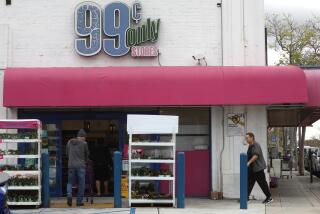Penny-Foolish : ‘I Imagine Some People Actually Believe That Something That Costs $1.99 Is Closer to $1 Than to $2’
- Share via
Everyone has a pet peeve, whether it is a common grammatical error, such as the use of “lay” for “lie,” or trucks that drive over the speed limit, or people who litter the sidewalks.
James R. Pratley of San Diego is peeved about the pennies he collects because of the idiotic policy of merchants in pricing so many items at so many dollars and 99 cents.
Pratley complains that he periodically has to unload pockets full of pennies acquired as change in such transactions.
“Who in his right mind,” he asks, “is going to be tempted to buy at $1.99 instead of $2, or is stupid enough to drive an extra block to save one cent for every 10 gallons of gasoline (at $1.189 per gallon)?
“With the exception of gasoline,” he goes on, “all prices are then subject to sales tax, and assuming that the tax is 6%, any item priced at $1.99 costs $2.11 instead of the $2.12 if initially priced at $2.
“Would it not be much better to round all prices to at least the nearest nickel or even dollar, and better still to follow the lead of the oil companies and include the sales tax in the price of the item?
“It seems to me that untold millions of dollars could be saved by all concerned by doing away with trivial and sometimes mythical savings in advertised pricing, and at the same time saving the customer’s pants pocket or purse from overload and possible short-circuit.”
I have been mystified since I was a small boy by the practice of merchants in pricing their goods at so much plus 99 cents or 99 dollars; or even 999 dollars (for automobiles).
I imagine they keep doing it because some people actually believe that something that costs $1.99 is closer to $1 than to $2, or because they can deceive their spouses that it is.
I remember that my mother knowingly went for that kind of delusory pricing and often bought things because they were “only” $2.99 instead of $3.
When she had bought something that was “only” $2.99, she quickly forgot the 99 cents and would tell people, including my dubious father, that she had bought it for “two-something.”
She would show my father a hat she had bought and would boast that “I got it at the May Co. for four-something.”
My father in time got wise to this deceit and assumed that anything that cost “four-something” actually came within one cent of costing $5.
Naturally, when the articles purchased ran into big money, like a dining room set or a fur coat, the 99 would represent dollars, not cents, and she would say that she had got something for “four hundred and something,” meaning, of course, $499, or just a dollar shy of $500.
My mother was not a stupid woman, and she was especially good with figures, so I doubt she was really fooled by the alteration of $1.99 to “a dollar-something.” Yet, for some reason she seemed unable to resist anything priced at “something ninety-nine.”
I don’t know if stores have them anymore, since it is hard to find anything for less than a dollar these days, but they used to have periodic 99-cent sales, when a large number of articles would be priced at 99 cents.
Those 99-cent sales would drive my mother into a frenzy of foolish purchasing. She would come home with sacks of trifles she had bought for “less than a dollar.”
I agree with Pratley that this policy merely creates troves of pennies, which soon fill one’s ashtrays and have to be stowed in large glass jars or beer mugs for one’s grandchildren.
I almost never go shopping without coming home with a pocketful of pennies, which I drop into one of these receptacles. At the moment, I have a huge ceramic beer stein from Whittier College that is filled to the brim with pennies, and I am about halfway to the top of a Mason jar.
Naturally, I could avoid this plethora of pennies if I would take a dozen or so with me whenever I go out and use them to pay my bills exactly, to the cent. Thus, if lunch was $5.96, I would give the cashier $6 and six pennies, and get a dime back instead of four pennies.
But who has the foresight and patience to carry a pocketful of pennies?
Life indeed would be neater if all stores marked every item at $1 even, including tax, or $1.05, including tax; or priced things so that when the tax was added they would come out even.
But it will never happen.
Too many people are like my mother.
More to Read
Inside the business of entertainment
The Wide Shot brings you news, analysis and insights on everything from streaming wars to production — and what it all means for the future.
You may occasionally receive promotional content from the Los Angeles Times.










